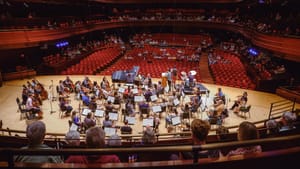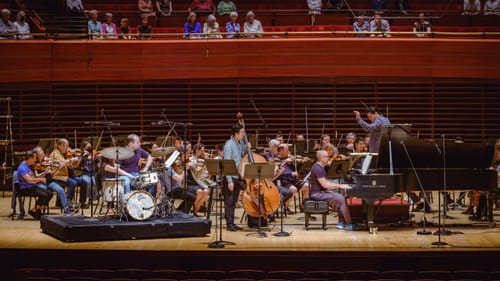Stay in the Loop
BSR publishes on a weekly schedule, with an email newsletter every Wednesday and Thursday morning. There’s no paywall, and subscribing is always free.
A symphonic sneak peek
Philadelphia Orchestra open rehearsals take music lovers of all ages behind the scenes of the symphony

Symphony orchestras have been a tantalizing topic for a variety of audiences in recent years thanks to the success of films like Maestro (a docudrama about the late conductor Leonard Bernstein) and Tár (a fictional tale of a conductor played by Cate Blanchett). There’s also Beyond the Baton, a 2022 PBS documentary on Thomas Wilkins, a Black conductor who has broken barriers and brought symphonic music to a new array of listeners (you can stream it for free until Saturday, February 1, 2025).
Yet, while most music lovers are familiar with the image of a conductor in evening wear leading a large ensemble, many may be unaware of the prep that goes into readying up to 100 or more musicians (and sometimes choruses and soloists) for this musical creation. Open rehearsals, or practice sessions with invited guests, offer a window into this process.
Donors and students
For decades, the Philadelphia Orchestra has been offering open rehearsals, a sneak peek at the inner workings of a world-class symphonic ensemble. A spokesperson for the orchestra told me that they are extremely popular with young people and seasoned donors alike.
There may be four or five total rehearsals in the week before a concert. Unlike closed rehearsals that are exclusively for performance participants, open rehearsals welcome the presence of certain audiences. For the Philadelphia Orchestra, these audiences are school groups (which fill up quickly) and donors who consistently contribute at least $100 a year. Open rehearsals are free to participating school groups in the area. Find more info on the Ensemble Arts Philly website.
“We offer pretty broad access to schools throughout the region,” Jeremy Rothman, chief programming officer for the Philadelphia Orchestra and Ensemble Arts Philly, told me in a recent online conversation. “For donors, it is one of several benefits they receive in recognition of their support of the orchestra.” Participating Philadelphia Orchestra donors receive four tickets they may use throughout a season for open rehearsals. The benefit is also available to Ensemble Arts Philly donors who contribute at least $500 annually.
The rehearsal begins
But why would anyone want to attend an open rehearsal? What can you learn at a rehearsal that you wouldn’t learn more readily at a polished final performance? I wanted to see what the experience was like, so with the approval of the orchestra’s staff, I joined a 10:30am open rehearsal of a work renowned for its difficulties and length: Gustav Mahler’s Symphony No. 9. Artistic director, Yannick Nézet-Séguin, increasingly has garnered critical acclaim for his interpretations of works by this Austrian symphonist.
The first thing I noticed was the informal nature of the rehearsal. Here was a large symphonic orchestra, its members attired not in formal black but in the variegated colors and shapes of joggers, tees, and blue jeans. The overhead lights remained bright and undimmed, definitely a plus for someone inured to taking notes in the dark. Rehearsal attendees (about 100 of us) sat in the front-and-center floor section known as orchestra seating, while others who desired a good look at the conductor’s expressions spread out in the Conductor’s Circle above and behind the ensemble, where choruses sit during performances, which include singers.

Clad in navy sweats, Nézet-Séguin appeared suddenly from stage right and briskly stepped to the podium, baton in hand, to start the rehearsal. He looked even-tempered and ready to go. Yes, those attending open rehearsals see and hear the same musicians who will be performing in specific concerts, including classical celebrities, subject to change.
A different departure point
Already, I was starting to feel comfortable with an orchestra that was increasingly more approachable. It’s not that I preferred the laid-back atmosphere over an actual concert, but it gave me a different point of departure for approaching this music. It felt similar to looking at an artist’s painting and seeing their earlier sketches lurking beneath the surface.
Mahler’s gentle opening, with a cello and horn, then harp motif that some suggest resembles a syncopated heartbeat, seemed to rise from the ordinary to the sublime in several minutes. The four movements moved along thoughtfully, with numerous pauses as the conductor went over a phrase or directed a change in tone. During uninterrupted periods, the conductor seemed to take us on a dream-like journey into a musical world where time stood still.
While I couldn’t make out all the conductor’s corrections and observations, my colleague pointed out the presence of Naomi Woo, assistant conductor, seated near the front, jotting down the conductor’s remarks on sticky notes and placing them tenderly in the voluminous score. They would provide a helpful reminder when the symphony was performed formally later that day during a matinee that also featured Jake Heggie’s Songs for Murdered Sisters.
Navigating the world with music
There was a lot of sadness in the world on the day of this particular open rehearsal, like California wildfires and the funeral of President Jimmy Carter. Heggie’s song cycle expressing Margaret Atwood’s moving poetry echoed the feeling. Even the Ninth Symphony itself has been called Mahler’s paean to his young daughter, Maria Anna, who died in 1907.
And yet, music on a grand symphonic scale helps us deal with, rather than recoil from, the darkest shadows, whether they rise from crime, natural disasters, or reflections on lives lived long or cut far too short.
The architecture of the open rehearsal helps us navigate works of music, become friends with performers and their instruments, and move past speed bumps and detours to confront the composer’s message and our own untrammeled response. We see the musicians laugh and engage in repartee with the conductor, who in this case turns out to be not only a leader but also a likable guy. Middle and high school students find this a real-world lesson they can relate to, while supporters absorb the sound deep into their bones. Either way, these rehearsals open a window into our shared humanity.
Here are some of the Philadelphia Orchestra’s winter and spring 2025 open rehearsals:
- Thursday, January 23: Rafael Payare conducts Tchaikovsky’s Sixth Symphony, Ravel’s Suite No. 2 from Daphnis and Chloe, and Kaija Saariaho’s violin concerto featuring Carolin Widmann. Open to donors.
- Thursday, March 13: Marin Alsop conducts the final rehearsal before the world premiere of Gabriela Lena Frank’s Picaflor: A Future Myth, Brahms’s Variations on a Theme of Haydn, and Mendelssohn’s Violin Concerto featuring Randall Goosby. Open to donors and students.
- Thursday, April 3: Nézet-Séguin leads Stravinsky’s complete Firebird score, Assiginaak’s Eko-Bmijwang (As Long in Time as the River Flows), and Bartók’s Second Violin Concerto featuring First Associate Concertmaster Juliette Kang. Open to donors.
- Thursday, May 1: Tugan Sokhiev conducts Liszt’s Piano Concerto No. 1 featuring Haochen Zhang, Wagner’s Overture to Tannhauser, Strauss’s Till Eulenspiegel’s Merry Pranks and “Dance of the Seven Veils,” from Salome. Open to donors and students.
What, When, Where
Open rehearsals for the Philadelphia Orchestra’s winter and spring 2025 concerts. Through May 2025 at the Kimmel Cultural Campus's Marian Anderson Hall, 300 S Broad Street, Philadelphia. (215) 893-1999 or philorch.org.
Accessibility
The Kimmel Cultural Campus is an ADA-compliant venue. Patrons can purchase wheelchair seating or loose chairs online by calling patron services at (215) 893-1999 or emailing patron services. With advance notice, patron services can provide options for personal care attendants, American Sign Language, Braille tickets and programs, audio descriptions, and other services.
Sign up for our newsletter
All of the week's new articles, all in one place. Sign up for the free weekly BSR newsletters, and don't miss a conversation.

 Linda Holt
Linda Holt